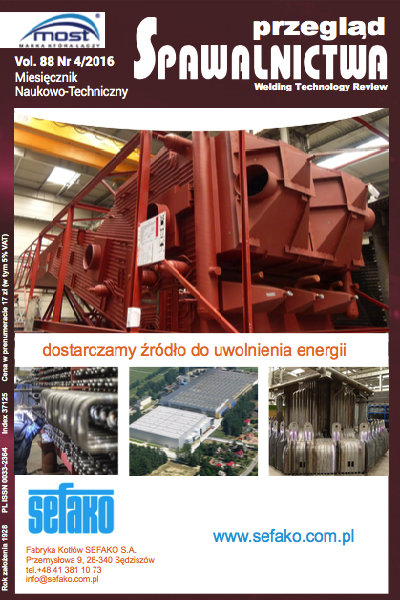Mikrostruktura i własności złączy naprawczych wykonanych na stopie Hastelloy X przed i po eksploatacji w turbinie gazowej
##plugins.themes.bootstrap3.article.main##
Abstrakt
Przedmiotem badań były złącza spawane ze stopu niklu umacnianego roztworowo o nazwie handlowej Hastelloy X. Proces spawania przeprowadzono metodą GTAW (z ang. Gas Tungsten Arc Welding) na materiale w stanie dostawy oraz po eksploatacji tj. pochodzącym z turbiny gazowej. W celu porównania zmian mikrostrukturalnych i własności wykonano badania za pomocą mikroskopii świetlnej, skaningowej oraz pomiary mikrotwardości. Dodatkowo przeprowadzono badania za pomocą transmisyjnej mikroskopii elektronowej (TEM) w obszarze materiału rodzimego po eksploatacji. Wykonane badania TEM były podstawą do stwierdzenia, iż temperatura eksploatacji wpłynęła jedynie na zwiększenie ilości i średnicy wydzieleń węglików typu M6C, natomiast temperatura eksploatacji leżała poza zakresem wydzielania faz wtórnych węglików typu M23C6 i faz topologicznie zwarcie wypełnione σ lub μ. Hastelloy X w stanie przesyconym charakteryzuje się bardzo dobrą spawalności, jednakże może ona ulec obniżeniu w wyniku obecności kruchych i niskotopliwych faz powstałych w trakcie eksploatacji.
Microstructure and properties of repair welds with the use of Hastelloy X alloy in the delivery condition and after long term service
Abstract
The aim of the present study was to characterize repair welds performed on solid solution strengthened nickel-based superalloy also known Hastelloy X. The welding process was performed using GTAW. Process was carried out on materials in solid solution condition (unaged state) and after long term service in gas turbine. In order to compare microstructural changes and properties of welds light microscopy, scanning electron microscopy and microhardness measurements were performed. Additionally, transmission electron microscopy (TEM) of the base material after long term service was carried out. TEM study was the basis for the conclusion that the operating temperature had an impact on increase the amount and diameter of M6C-type carbides. Operating temperature of the turbine part was too low to contribute to the precipitation of M23C6- type carbides and topologically closed packed phases σ and μ. Alloy in solid solution condition has excellent weldability but precipitation of brittle and low melting temperature constituents during service may affect the tendency to cracking.
Pobrania
##plugins.themes.bootstrap3.article.details##
Creative Commons CC BY 4.0 https://creativecommons.org/licenses/by/4.0/
Artykuły czasopisma Welding Technology Review (Przegląd Spawalnictwa) publikowane są w otwartym dostępie na licencji CC BY (licencja Creative Commons Uznanie autorstwa 4.0 Międzynarodowe). Licencja CC BY jest najbardziej otwartą dostępną licencją i uważaną za „złoty standard” w formule otwartego dostępu; jest również preferowany przez wielu fundatorów badań. Licencja ta umożliwia czytelnikom kopiowanie i redystrybucję materiału na dowolnym nośniku i w dowolnym formacie, a także zmienianie, przekształcanie lub budowanie na nim materiału, w tym do użytku komercyjnego, pod warunkiem wskazania oryginalnego autora.
Bibliografia
M.B. Henderson, D. Arrell, Larsson, G, M. Heobel, R.: Marchant Nickel based superalloy welding practices for industrial gas turbine applications. Science and Technology of Welding and Joining 2004; Vol. 9, No.1: 13-21.
F. Najafzadegan,, H. Mansori, M. Shamanian, Investigation Of Microstruc- ture Of The Weld Zone Of Hastelloy X Via Pulsed Nd-Yag Laser Welds. Journal Of Advanced Materials And Processing 2013; Vol.1, No. 4: 49-56.
J.-C. Zhao, M. Larsen, V. Ravikumar, Phase precipitation and timetem- perature transformation diagram of Hastelloy X. Materials Science and Engineering 2000; A293: 112119
http://www.hayneswire.com/weldingproducts.html
J. N. Dupont, J. C. Lippold, S.D Kiser, Welding metallurgy and weldability of nickel-base alloys, A John Wiley & Sons, Inc.; 2009.
